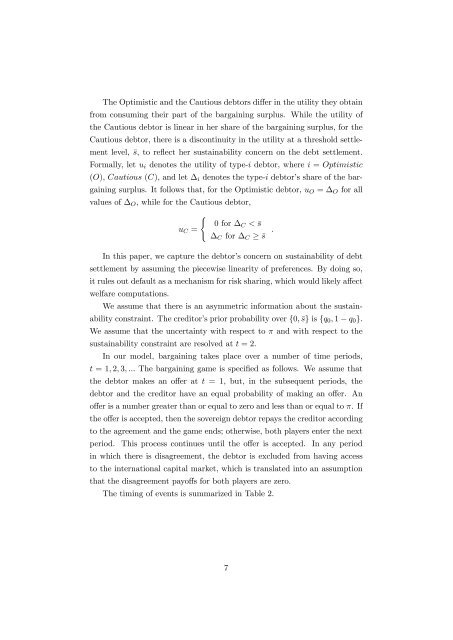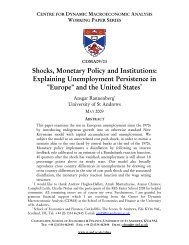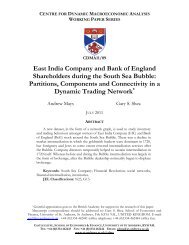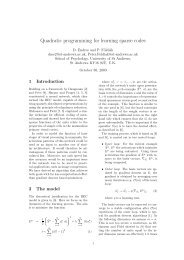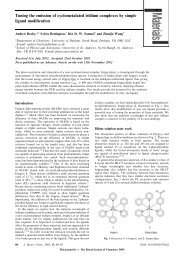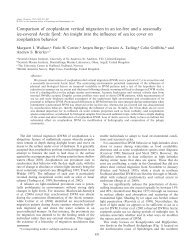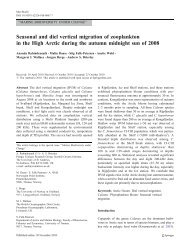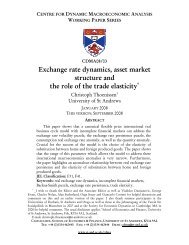Delay and Haircuts in Sovereign Debt - University of St Andrews
Delay and Haircuts in Sovereign Debt - University of St Andrews
Delay and Haircuts in Sovereign Debt - University of St Andrews
Create successful ePaper yourself
Turn your PDF publications into a flip-book with our unique Google optimized e-Paper software.
The Optimistic <strong>and</strong> the Cautious debtors di¤er <strong>in</strong> the utility they obta<strong>in</strong><br />
from consum<strong>in</strong>g their part <strong>of</strong> the barga<strong>in</strong><strong>in</strong>g surplus. While the utility <strong>of</strong><br />
the Cautious debtor is l<strong>in</strong>ear <strong>in</strong> her share <strong>of</strong> the barga<strong>in</strong><strong>in</strong>g surplus, for the<br />
Cautious debtor, there is a discont<strong>in</strong>uity <strong>in</strong> the utility at a threshold settlement<br />
level, s, to re‡ect her susta<strong>in</strong>ability concern on the debt settlement.<br />
Formally, let u i denotes the utility <strong>of</strong> type-i debtor, where i = Optimistic<br />
(O), Cautious (C), <strong>and</strong> let i denotes the type-i debtor’s share <strong>of</strong> the barga<strong>in</strong><strong>in</strong>g<br />
surplus. It follows that, for the Optimistic debtor, u O = O for all<br />
values <strong>of</strong> O , while for the Cautious debtor,<br />
u C =<br />
(<br />
0 for C < s<br />
C for C s :<br />
In this paper, we capture the debtor’s concern on susta<strong>in</strong>ability <strong>of</strong> debt<br />
settlement by assum<strong>in</strong>g the piecewise l<strong>in</strong>earity <strong>of</strong> preferences. By do<strong>in</strong>g so,<br />
it rules out default as a mechanism for risk shar<strong>in</strong>g, which would likely a¤ect<br />
welfare computations.<br />
We assume that there is an asymmetric <strong>in</strong>formation about the susta<strong>in</strong>ability<br />
constra<strong>in</strong>t. The creditor’s prior probability over f0; sg is fq 0 ; 1 q 0 g.<br />
We assume that the uncerta<strong>in</strong>ty with respect to <strong>and</strong> with respect to the<br />
susta<strong>in</strong>ability constra<strong>in</strong>t are resolved at t = 2.<br />
In our model, barga<strong>in</strong><strong>in</strong>g takes place over a number <strong>of</strong> time periods,<br />
t = 1; 2; 3; ::: The barga<strong>in</strong><strong>in</strong>g game is speci…ed as follows. We assume that<br />
the debtor makes an o¤er at t = 1, but, <strong>in</strong> the subsequent periods, the<br />
debtor <strong>and</strong> the creditor have an equal probability <strong>of</strong> mak<strong>in</strong>g an o¤er. An<br />
o¤er is a number greater than or equal to zero <strong>and</strong> less than or equal to . If<br />
the o¤er is accepted, then the sovereign debtor repays the creditor accord<strong>in</strong>g<br />
to the agreement <strong>and</strong> the game ends; otherwise, both players enter the next<br />
period. This process cont<strong>in</strong>ues until the o¤er is accepted. In any period<br />
<strong>in</strong> which there is disagreement, the debtor is excluded from hav<strong>in</strong>g access<br />
to the <strong>in</strong>ternational capital market, which is translated <strong>in</strong>to an assumption<br />
that the disagreement payo¤s for both players are zero.<br />
The tim<strong>in</strong>g <strong>of</strong> events is summarized <strong>in</strong> Table 2.<br />
7


